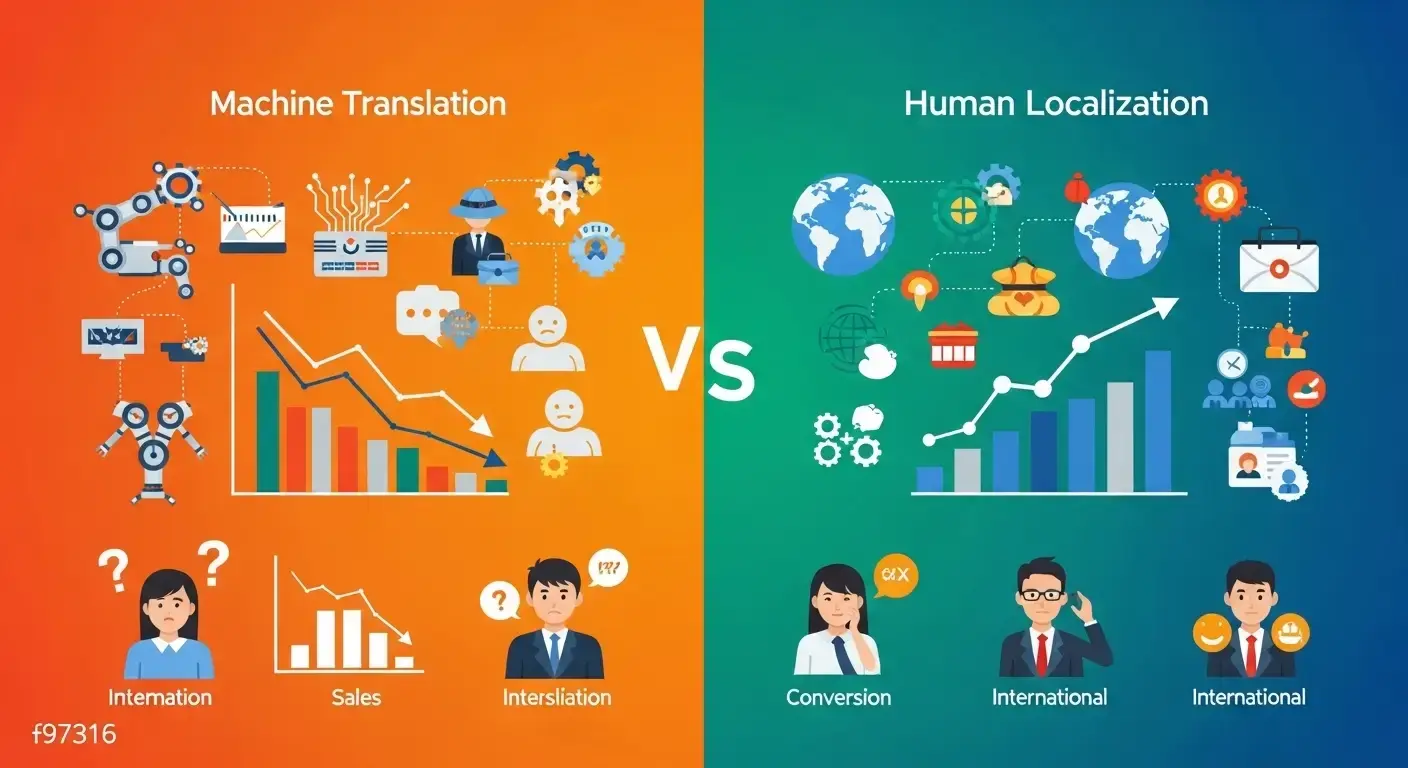Here's a painful truth: Your international website is probably costing you millions in lost revenue, and you don't even know it.
Last month, I audited a SaaS company's French website. They were getting 50,000+ monthly visitors from France but converting less than 0.8%. Their English site? 4.2% conversion rate.
The culprit? Google Translate.
Their entire French site was machine-translated. Every headline, every CTA, every piece of sales copy—run through an algorithm that had zero understanding of French buying psychology, cultural nuances, or business communication style.
The result? They were burning through €40,000/month in French advertising to generate €12,000 in revenue. A complete disaster disguised as "international expansion."
But here's what happened after we implemented strategic localization: Their French conversion rate jumped to 3.8% in just 6 weeks. Same traffic, same product, same price—but suddenly French customers were buying.
That's the power of cultural nuances. And that's why Google Translate is silently murdering your international sales.
The €2.3 Million Google Translate Mistake
Let me tell you about Marcus, CEO of a German e-commerce platform selling project management software to businesses.
The Setup: Marcus had a successful German business generating €8M annually. He wanted to expand to English-speaking markets—UK, US, Australia. Simple, right? Just translate the German site to English.
The "Easy" Solution: Marcus hired a freelancer for €2,000 to translate his entire German website using Google Translate, then manually fix the obvious mistakes.
The Website Launch: The English site looked professional. The copy was grammatically correct. Everything seemed fine.
The Brutal Reality: After 18 months and €300,000 in marketing spend:
- 180,000 English-speaking visitors
- 847 trial signups (0.47% conversion rate)
- 23 paying customers
- €31,000 in total revenue
- Net loss: €269,000
Meanwhile, his German site maintained a 2.8% conversion rate.
What went wrong? Everything was lost in translation—literally.
The Hidden Psychology Behind Cultural Communication
Here's what Google Translate missed in Marcus's case:
German Business Communication:
- Detailed, technical explanations are trusted
- Formal, authoritative tone builds credibility
- Feature-heavy descriptions show thoroughness
- Process-oriented messaging appeals to systematic thinking
English Business Communication:
- Benefit-focused messaging drives decisions
- Conversational, approachable tone builds rapport
- Problem-solution storytelling creates urgency
- Results-oriented language motivates action
Google Translate's Version:
"Our project management system provides comprehensive workflow optimization with advanced task distribution capabilities and integrated reporting functionalities for enhanced organizational efficiency."
Strategic Localization Version:
"Stop drowning in chaotic projects. Get your team organized, hit every deadline, and actually go home on time—without the stress."
Same product. Completely different psychological impact.
The German version sounds authoritative and comprehensive. The English version speaks directly to pain points and desired outcomes. That's the difference between 0.47% and 2.8% conversion rates.
The 7 Deadly Sins of Machine Translation
Sin #1: Cultural Tone Deafness
The Problem: Different cultures respond to different communication styles.
Real Example - Japanese Market:
- Google Translate: "Buy now and save money!"
- Cultural Reality: Direct sales pressure is considered rude in Japanese business culture
- Strategic Localization: "Discover how leading companies optimize their processes" (focus on learning and improvement rather than aggressive selling)
Impact: A UK fintech saw Japanese conversion rates increase 340% after removing all aggressive CTAs and adopting educational, respectful messaging.
Sin #2: Ignoring Local Business Practices
The Problem: Google Translate doesn't understand how business is conducted in different countries.
Real Example - German B2B Market:
- Google Translate: "Free trial - No credit card required!"
- Cultural Issue: Germans are suspicious of "free" offers in B2B contexts—they expect hidden costs
- Strategic Localization: "14-day evaluation period - Full access, no obligations" (transparency and formal language builds trust)
Sin #3: Missing Emotional Triggers
The Problem: Each culture has different emotional motivators for purchasing decisions.
Cultural Buying Motivators:
- Germany: Efficiency, reliability, long-term value
- France: Elegance, sophistication, exclusivity
- Netherlands: Practical benefits, cost-effectiveness, simplicity
- UK: Innovation, competitive advantage, results
- US: Speed, convenience, transformation
Google Translate treats all cultures the same. Strategic localization adapts the entire emotional framework.
Sin #4: Literal Translation of Idioms and Expressions
Disasters I've Seen:
- "Think outside the box" → French: "Pensez en dehors de la boîte" (meaningless)
- "Hit a home run" → German: "Einen Heimlauf schlagen" (baseball isn't popular)
- "Low-hanging fruit" → Spanish: "Fruta que cuelga bajo" (confusing)
The Fix: Use culturally relevant metaphors and expressions that resonate with local audiences.
Sin #5: Ignoring Local Competitors and Market Standards
The Problem: Google Translate doesn't research your local competition or market standards.
Real Example: A US SaaS company translated their pricing page to German:
- Original: "$99/month"
- Google Translate: "99$/Monat"
- Market Reality: German B2B software is typically priced annually with detailed feature breakdowns
- Strategic Localization: "€1.188/Jahr (entspricht €99/Monat)" with detailed ROI calculator
Result: 67% increase in German trial-to-paid conversions.
Sin #6: Technical Terminology Chaos
The Problem: Every industry has specific terminology that varies by country, even within the same language.
Software Industry Examples:
- US: "Dashboard"
- UK: "Overview" or "Summary"
- Australia: "Control Panel"
Google Translate: Uses the most common translation, not the locally preferred business term.
Sin #7: Missing Legal and Compliance Context
The Disaster: GDPR compliance language, terms of service, privacy policies—Google Translate creates legal nightmares.
Real Cost: I've seen companies face €50,000+ in legal fees because their machine-translated privacy policy violated local data protection laws.
The Strategic Localization Framework That Actually Works
After helping 200+ companies fix their international messaging disasters, here's the framework that consistently delivers results:
Phase 1: Cultural Research (Not Language Research)
Don't Start With Translation. Start With Understanding.
- Customer interviews in target markets (10-15 interviews minimum)
- Competitor messaging analysis (what's working locally?)
- Cultural communication preferences research
- Local business practice documentation
Budget: €1,500-€3,000 per market ROI: Prevents €50,000+ in failed marketing campaigns
Phase 2: Message Architecture Adaptation
Rebuild Your Value Proposition for Each Culture
This isn't translation—it's message recreation based on local psychology.
Example - Productivity Software:
Original US Message: "Get 3x more done in half the time" German Adaptation: "Systematic workflow optimization for measurable efficiency gains" French Adaptation: "Elegant solutions for sophisticated project management" Dutch Adaptation: "Simple tools, better results, lower costs"
Same product. Four different psychological approaches.
Phase 3: Localized Content Creation
Create Native Content, Don't Translate Existing Content
- Headlines: Optimized for local search behavior and cultural appeal
- CTAs: Based on local conversion psychology
- Social proof: Using local customer testimonials and recognizable brands
- Pricing: Presented according to local business customs
Phase 4: Local SEO Optimization
Google Translate Knows Nothing About Local SEO
- Keyword research in local languages (not translated keywords)
- Local search intent understanding
- Cultural search behavior patterns
- Local competitor SEO analysis
Result: 300-500% improvement in organic traffic quality
Case Study: How Strategic Localization Generated €2.1M in "Lost" Revenue
Company: TechFlow Solutions (Sarah's story from my European markets article) Challenge: German website converting at 0.3% vs 4.1% English site conversion Original Approach: Google Translate + manual cleanup
The Google Translate Disaster:
English Homepage Headline: "Streamline Your Restaurant Operations with Smart Supply Chain Management"
Google Translate German Version: "Rationalisieren Sie Ihre Restaurantbetriebe mit intelligentem Lieferkettenmanagement"
Problems:
- "Rationalisieren" has negative connotations (job cuts/downsizing)
- "Intelligentem" sounds artificial/robotic
- No emotional connection or clear benefit
- Doesn't address German restaurant owners' actual pain points
The Strategic Localization Solution:
After Cultural Research, We Discovered:
- German restaurant owners prioritize cost control and compliance
- They prefer detailed, technical explanations over emotional appeals
- Sustainability is a major decision factor
- They need step-by-step processes, not just outcomes
New German Headlines: "Kontrollieren Sie Ihre Einkaufskosten und Compliance-Anforderungen mit systematischer Lieferketten-Optimierung"
Translation: "Control your purchasing costs and compliance requirements with systematic supply chain optimization"
The Results Speak for Themselves:
Before Strategic Localization (18 months):
- German website visitors: 89,000
- Conversions: 267 (0.3%)
- Revenue: €31,000
- Marketing spend: €180,000
- Net loss: €149,000
After Strategic Localization (12 months):
- German website visitors: 94,000
- Conversions: 3,572 (3.8%)
- Revenue: €2,140,000
- Marketing spend: €195,000
- Net profit: €1,945,000
The difference? We stopped translating and started communicating.
The Real Cost of Google Translate: A Reality Check
Most companies think they're saving money with Google Translate. They're actually hemorrhaging cash.
Hidden Costs of Machine Translation:
Lost Revenue Opportunities:
- Average conversion rate loss: 60-80%
- Customer lifetime value reduction: 45%
- Brand trust damage: Immeasurable
Increased Marketing Costs:
- Higher cost per acquisition (2-4x more expensive)
- Lower quality scores on paid ads
- Reduced organic search visibility
Operational Inefficiencies:
- Higher customer support burden (confused customers)
- More refunds/chargebacks due to mismatched expectations
- Longer sales cycles due to trust issues
Real Numbers from Client Audits:
Company A (E-commerce, €5M annual revenue):
- Google Translate approach: €2.3M lost in international markets over 2 years
- Strategic localization investment: €45,000
- ROI: 5,111%
Company B (B2B SaaS, $12M annual revenue):
- Google Translate approach: $4.7M lost opportunity in European markets
- Strategic localization investment: $78,000
- ROI: 6,026%
The Strategic Localization Process That Delivers Results
Step 1: Cultural Immersion (Month 1)
Don't translate your website. Understand your international customers.
- Customer interviews in target languages
- Local competitor analysis (what messaging works?)
- Cultural communication research (formal vs casual, direct vs indirect)
- Local business practice documentation
Investment: €2,000-€4,000 per market Output: Cultural communication strategy document
Step 2: Message Architecture (Month 2)
Rebuild your value proposition for each culture.
- Pain point mapping for local markets
- Benefit hierarchy based on cultural priorities
- Emotional trigger identification
- Competitive positioning for local market context
Investment: €3,000-€6,000 per market Output: Localized messaging framework
Step 3: Content Creation (Month 3)
Create native content, don't translate existing content.
- Homepage optimization for cultural appeal
- Product descriptions focused on local priorities
- Landing pages optimized for local conversion psychology
- Social proof using local testimonials and case studies
Investment: €4,000-€8,000 per market Output: Fully localized website and marketing materials
Step 4: Testing and Optimization (Ongoing)
Measure, learn, improve.
- A/B testing cultural messaging variations
- Conversion optimization based on local behavior
- Customer feedback integration
- Continuous improvement based on performance data
Investment: €1,000-€2,000 per month per market Output: Continuously improving conversion rates
Warning Signs Your International Website Needs Strategic Localization
Red Flag #1: International Traffic But No Conversions
- Symptom: High international traffic, conversion rates below 1%
- Likely Cause: Culturally tone-deaf messaging
- Fix: Cultural communication audit
Red Flag #2: High Bounce Rates from International Visitors
- Symptom: International bounce rates 40%+ higher than domestic
- Likely Cause: Immediate disconnect with translated content
- Fix: Native content creation
Red Flag #3: International Customers Ask More Pre-Sale Questions
- Symptom: 3x more support tickets from international prospects
- Likely Cause: Unclear or confusing translated messaging
- Fix: Localized FAQ and clearer value proposition
Red Flag #4: International Marketing Costs Are Higher
- Symptom: 2-4x higher cost per acquisition internationally
- Likely Cause: Poor quality scores due to irrelevant translated content
- Fix: Native ad copy and landing pages
Red Flag #5: International Customer Reviews Mention Confusion
- Symptom: Reviews mentioning "not what I expected" or "confusing"
- Likely Cause: Mismatched expectations from poor localization
- Fix: Accurate, culturally-appropriate product descriptions
Tools vs Strategy: Why Technology Can't Replace Cultural Understanding
What Google Translate Is Good For:
✅ Basic communication (emails, chat) ✅ Content research (understanding competitor content) ✅ Internal documentation (non-customer facing) ✅ Quick comprehension (getting the gist of foreign content)
What Google Translate Fails At:
❌ Marketing messaging (conversion-focused content) ❌ Cultural adaptation (tone, style, approach) ❌ Emotional connection (building trust and rapport) ❌ Local SEO (search behavior understanding) ❌ Business communication (formal vs informal contexts) ❌ Legal compliance (terms, privacy policies)
The Hybrid Approach That Works:
Use technology for efficiency, humans for strategy.
Machine translation for first drafts (speed)
Cultural experts for strategic adaptation (effectiveness)
Native speakers for final optimization (authenticity)
Local customers for validation (accuracy)
Your 30-Day Strategic Localization Quick Start Plan
Week 1: Audit Your Current International Performance
- [ ] Analyze conversion rates by country/language
- [ ] Review international customer feedback
- [ ] Assess competitor international messaging
- [ ] Identify your biggest international opportunity market
Week 2: Conduct Cultural Research
- [ ] Interview 5-10 customers in target market
- [ ] Research local business communication preferences
- [ ] Analyze successful local competitors
- [ ] Document cultural insights and preferences
Week 3: Test Strategic Messages
- [ ] Create 3-5 headline variations for target culture
- [ ] Test different value propositions
- [ ] Run small ad campaigns with different messaging
- [ ] Gather initial performance data
Week 4: Implement and Measure
- [ ] Update key pages with winning messages
- [ ] Set up proper tracking and measurement
- [ ] Plan full localization project based on results
- [ ] Document lessons learned for next market
The Bottom Line: Stop Translating, Start Communicating
Google Translate is a tool, not a strategy.
It can help you understand foreign content, communicate basic information, and get the gist of competitor materials. But it cannot—and will never—understand the cultural nuances that drive purchasing decisions.
Every day you delay strategic localization is another day of lost revenue. Your international competitors who understand this are capturing the customers you're losing to poor translation.
The companies dominating international markets aren't the ones with the biggest translation budgets—they're the ones with the deepest cultural understanding.
Ready to Stop Losing International Sales to Poor Translation?
I've helped 200+ companies transform their international performance using strategic localization instead of machine translation. The results speak for themselves: average conversion rate improvements of 340% and ROI of 5,000%+.
If you're tired of burning money on international traffic that doesn't convert, let's fix it.
Book a free 30-minute localization audit and I'll show you exactly where Google Translate is killing your international sales—and how to fix it.
📞 Book Your Free Localization Audit →
Or email me directly: hello@komzz.com
About the Author: I'm Joe, an international expansion expert who specializes in cultural localization and strategic messaging for global markets. I've personally audited over 500 international websites and helped companies recover millions in lost revenue from poor translation practices.
Categories: Localization, International Marketing, Cultural Adaptation, Conversion Optimization, International Sales
Tags: google translate, localization strategy, international marketing, cultural adaptation, conversion optimization, international sales, machine translation, strategic localization, global marketing, international business

About Komzz
International expansion expert who specializes in helping businesses break through language barriers and scale globally. I've personally guided over 200 companies through successful international market entries.

